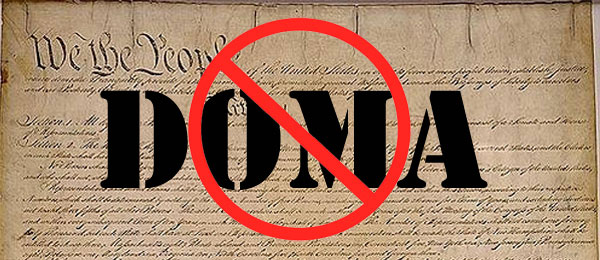In 2011, President Obama called the Defense of Marriage Act “unconstitutional” and said his administration would stop enforcing it.1 Now, the Supreme Court has followed suit, declaring the act constitutionally flawed. One delighted citizen tweeted, “I’m not a legal expert but I think this ruling officially makes [lesbian] Ellen [DeGeneres] our new ruler.”2
 Perhaps not yet. But how sweeping is the ruling in Windsor v. US (2013), where the Supreme Court said the federal government had no business acting through the Defense of Marriage Act “to impose restrictions and disabilities” on homosexual couples whom certain states had recognized as duly married? Technically, particular states may still draw lines against it. The Gay & Lesbian Advocates and Defenders (GLAD) got it, when they urged their constituency to “keep in mind” that “The Supreme Court’s ruling in Windsor applies only to the federal government. It does not change discriminatory state laws excluding same-sex couples from state-conferred marriage rights.”3
Perhaps not yet. But how sweeping is the ruling in Windsor v. US (2013), where the Supreme Court said the federal government had no business acting through the Defense of Marriage Act “to impose restrictions and disabilities” on homosexual couples whom certain states had recognized as duly married? Technically, particular states may still draw lines against it. The Gay & Lesbian Advocates and Defenders (GLAD) got it, when they urged their constituency to “keep in mind” that “The Supreme Court’s ruling in Windsor applies only to the federal government. It does not change discriminatory state laws excluding same-sex couples from state-conferred marriage rights.”3
Of course, GLAD hopes that the states will fall in line one after another, but it could go the other way—in two ways. States could conceivably change their minds against gay marriage, or Windsor could be reversed, despite the principle of stare decisis (Latin for “stand by things decided”).4 It applies to the way in which court decisions serve as precedents or authorities for subsequent rulings and policies. If it weren’t for this principle, social and civic life would be chaos. Families, churches, schools, businesses, and agencies would not know how to plan.
Of course, “normal” rulings can be chaotic as well, so there are rocks on both sides. But respect for precedent has its place. Certainly, those who love a particular ruling want it to stand forever. That’s why abortion enthusiasts on the Senate Judiciary Committee press candidates for the Supreme Court to affirm that Roe v. Wade is “settled law,” as when John Roberts was queried by Sen. Arlen Specter.5 Roberts agreed that disregarding stare decisis could mean “a jolt to the legal system.” But, he continued, some long-standing cases deserve to be overturned, such as those that legalized slavery in the 19th century and racial segregation in the 20th century.6
Roberts was, of course, referring to the Dred Scott decision (1857), which declared a slave to be property, but was nullified by the 13th, 14th, and 15th Amendments to the Constitution; and to Plessy v. Ferguson (1954), which enshrined “separate but equal,” but was supplanted by Brown v. Board of Education (1954), which declared that separate was “inherently unequal.” And there are other examples: Loving v. Virginia (1967) dismissed Pace v. Alabama (1883), which had prohibited black/white marriage; Lawrence v. Texas (2003), negated Bowers v. Hardwick (1986), which had outlawed “sodomy”; West Coast Hotel v. Parrish (1937), set aside Lochner v. New York (1905) and Adkins v. Children’s Hospital (1923), both of which had said the state could not exercise control over work contracts in the private sector, e.g., re. working hours or minimum wage.
More recently, Citizens United v. Federal Election Commission (2010) set aside Austin v. Michigan Chamber of Commerce (1990), which had limited campaign contributions from corporations, associations, and unions. In that ruling, Justice Kennedy, explained that time could tell that the original judgment was unworkable and unreasonable, fraught with “shortcomings.”7
Still, gay-marriage proponents keep pressing toward their own version of Roe v. Wade, which knocked down virtually all opposition to abortion nationwide, but even if they succeed, history demonstrates that the matter is not finally settled. Perhaps the court will come to its senses, recognizing that, just as would be the case with incestuous and polygamist marriages (both still illegal), affirming gay marriage was, in Justice Kennedy’s words, an act of “sure error.”
—————————————
1 Charlie Savage and Sheryl Gay Stolberg, “In Shift, U.S. Says Marriage Act Blocks Gay Rights,” New York Times, February 23, 2011, http://www.nytimes.com/2011/02/24/us/24marriage.html?pagewanted=all&_r=0 (accessed October 24, 2013).
2 June 26 tweet by Andy Lassner cited in Nathan Nye, “19 Greatest Tweets About the Gay Marriage SCOTUS Decision,” Policy Mic Website, June 26, 2013, http://www.policymic.com/articles/51319/19-greatest-tweets-about-the-gay-marriage-scotus-decision (accessed October 24, 2013).
3 “The Supreme Court Ruling on the Defense of Marriage Act: What It Means,” Gay & Lesbians Advocates & Defenders (GLAD) Website (not to be confused with Gay & Lesbian Alliance Against Defamation [GLAAD]), http://www.glad.org/doma (accessed October 24, 2013).
4 The first word pronounced is pronounced “starry”; the second sounds like ‘decisive,’ but with an ‘s’ ending.
5 “John Roberts on Abortion,” On The Issues, http://www.ontheissues.org/court/john_roberts_abortion.htm (accessed October 24, 2013).
6 Amy Goldstein and Charles Babington, “Roberts Avoids Specifics on Abortion Issue,” Washington Post, September 14, 2005, http://www.washingtonpost.com/wp-dyn/content/article/2005/09/13/AR2005091300682_2.html (accessed October 24, 2013).
7 In his words:
Our precedent is to be respected unless the most convincing of reasons demonstrates that adherence to it puts us on a course that is sure error. Beyond workability, the relevant factors in deciding whether to adhere to the principle of stare decisis include the antiquity of the precedent, the reliance interests at stake, and of course whether the decision was well reasoned. We have also examined whether experience has pointed up the precedent’s shortcomings.